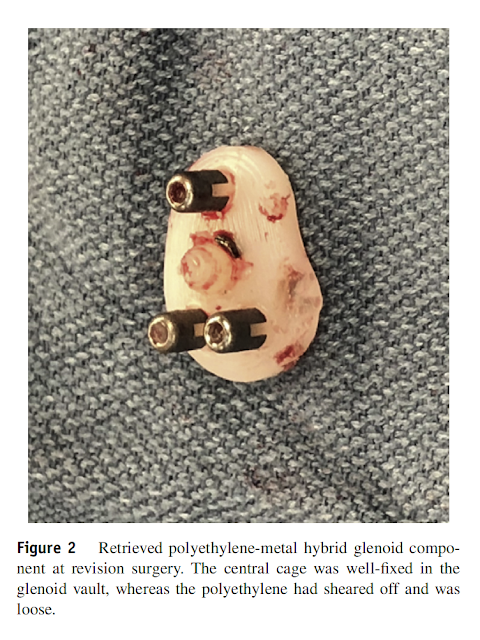These authors conducted a study of 5566 patients aged 18 years who underwent primary elective TSA for the diagnosis of osteoarthritis between 2010 and 2017. These data represent the experience of the Kaiser health system, which covers over 12.3 million members throughout 8 geographical regions in the United States, including Colorado, Georgia, Hawaii, the Mid-Atlantic, Northern California, the Northwest, Southern California, and Washington.
Patients with missing implant information, who received stemless humeral implants, or who received augmented glenoid implants, were excluded. Glenoid component designs used were categorized into 4 mutually exclusive treatment groups:
polyethylene central-pegged ingrowth, 39.2%
polyethylene-metal hybrid, 31.1%
polyethylene all-cemented pegged, 26.0%and
polyethylene cemented keeled, 3.6%
At 6-year final follow-up, 4.1% of TSA were revised for any cause, and 1.4% for glenoid loosening.
Both the polyethylene all-cemented pegged (HR . 2.48, 95% CI . 1.08-5.66) and polyethylene cemented keeled (HR . 3.84, 95% CI . 1.13-13.00) designs had higher risks for revision due to glenoid loosening in comparison to the central peg ingrowth and metal hybrid designs.
The authors noted a unique mechanism of failure for the hybrid glenoid in which the polyethylene separated from the caged central peg.
Comment: This is a well-done study of a huge patient cohort. The authors attempted to account for confounding in their multivariable regression analysis.
While they did not assess the role native glenoid morphology, they point to a recent international study of 1270 polyethylene glenoids with a central ingrowth peg that did not observe inferior outcomes in type B glenoids and those with over 15 degrees of retroversion (see this link).
This study supports the use of a standard all-polyethylene component with a central ingrowth peg, a design that has been in wide use for a decade (see this link).
To see a YouTube on how we do total shoulder arthroplasty with an emphasis on glenoid preparation, click on this link.
===
How you can support research in shoulder surgery Click on this link.
To see our new series of youtube videos on important shoulder surgeries and how they are done, click here.
Use the "Search" box to the right to find other topics of interest to you.
You may be interested in some of our most visited web pages arthritis, total shoulder, ream and run, reverse total shoulder, CTA arthroplasty, and rotator cuff surgery as well as the 'ream and run essentials'




